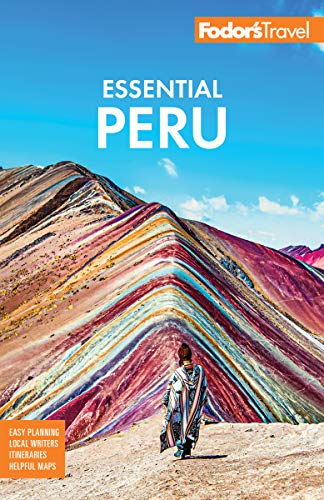Health and Safety
Altitude Sickness
Altitude sickness, known locally as soroche, affects the majority of visitors to Cusco, Puno, and other high-altitude locales in the Andes. Headache, dizziness, nausea, and shortness of breath are common. When you visit areas over 3,000 meters (10,000 feet) above sea level, take it easy for the first few days. Avoiding alcohol will keep you from getting even more dehydrated. To fight soroche, Peruvians swear by mate de coca, a tea made from the leaves of the coca plant. (If you are subject to any type of random drug testing through your workplace, know that coca tea can result in a positive test for cocaine afterward.) Some travelers swear by the prescription drug acetazolamide (brand name, Diamox), which should be taken 48 hours before arriving at altitude. Whether that's an appropriate course is for you and your health-care professional to decide.
Spend a few nights at lower elevations before you head higher, especially if you are hiking or climbing in the mountains. If you must fly directly to higher altitudes, plan on doing next to nothing for the first day or two. Drinking plenty of water or coca tea and taking frequent naps may also help. If symptoms persist, return to lower elevations. If you have high blood pressure or a history of heart trouble or are pregnant, check with your doctor before traveling to high elevations.
COVID-19
A novel coronavirus brought all travel to a virtual standstill in early 2020. Although the illness is mild in most people, some experience severe and even life-threatening complications. Until a vaccine is widely available, travelers must be particularly careful about hygiene and to avoid any unnecessary travel, especially if they are sick.
Starting two weeks before a trip, anyone planning to travel should be on the lookout for some of the following symptoms: cough, fever, chills, trouble breathing, muscle pain, sore throat, new loss of smell or taste. If you experience any of these symptoms, you should not travel at all.
To protect yourself during travel, do your best to avoid contact with people showing symptoms. Wash your hands often with soap and water. Limit your time in public places, and, when you are out and about, wear a cloth face mask that covers your nose and mouth. You may wish to bring extra supplies, such as disinfecting wipes, hand sanitizer (12-ounce bottles were allowed in carry-on luggage at this writing), and a first-aid kit with a thermometer.
Given how abruptly travel was curtailed in March 2020, it is wise to consider protecting yourself by purchasing a travel insurance policy that will reimburse you for any costs related to COVID-19-related cancellations. Not all travel insurance policies protect against pandemic-related cancellations, so always read the fine print.
Mosquito-borne Illnesses
Mosquitoes and sand flies are a problem in tropical areas, especially at dusk; infectious diseases can be passed via mosquitoes. If you are traveling in an area where malaria is prevalent, use a repellent containing DEET, and take malaria-prevention medication before, during, and after your trip as directed by your physician. Note: you may have to start antimalarial medication weeks before your trip so ask about it early. You may not get through airport screening with an aerosol can of mosquito repellent, so opt for a spritz bottle or cream. Local brands of repellent are readily available in pharmacies. If you plan to spend time in the jungle, be sure to wear clothing that covers your arms and legs, sleep under a mosquito net, and spray bug repellent in living and sleeping areas.
Speak with your physician and/or check the Centers for Disease Control or World Health Organization websites for health alerts, particularly if you're pregnant, traveling with children, or have a chronic illness.
Traveler's Diarrhea
The most common illness is traveler's diarrhea, caused by viruses, bacteria, or parasites in contaminated food or water. In Lima and much of the center of Cusco, water supplies are chlorinated and should be safe to use for washing fruits and vegetables. Although many limeños drink the tap water, travelers should drink bottled, boiled, or purified water and drinks to avoid any issues, even when brushing your teeth. Many higher-quality hotels do purify their water, so inquire with the concierge. In the provinces, water may not be treated. Wash fruits and vegetables before eating, and avoid ice (order drinks sin hielo, or "without ice") or make sure the ice cubes are made with purified water. If you buy food from a street vendor, make sure it's cooked in front of you. Note that water boils at a lower temperature at high altitudes and may not be hot enough to rid it of the bacteria, so consider using purification tablets or a portable water filter. Local brands include Micropur. Mild cases of traveler's diarrhea may respond to Imodium, Pepto-Bismol, or Lomotil, all of which can be purchased in Peru without a prescription. You can also ask your doctor for a prescription for Cipro or other antibiotic commonly used to treat traveler's diarrhea before you travel. Drink plenty of purified water or tea—manzanilla (chamomile) is a popular folk remedy as is the té anis, which has a licorice taste.
Immunizations
No vaccinations are required to enter Peru, however, the Centers for Disease Control and Prevention (CDC) recommends hepatitis A and typhoid inoculations for all travelers to Peru. Hepatitis B, rabies, yellow fever, and malaria should be discussed with your medical professional, depending on where you will be traveling. It's a good idea to have up-to-date boosters for tetanus, diphtheria, and measles. In those areas where rabies is a concern, many hospitals have antirabies injections, but as these must be taken in a series, prevention is far easier. Children traveling to Peru should have their vaccinations for childhood diseases up to date.




